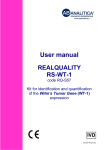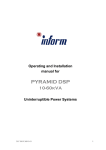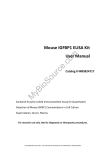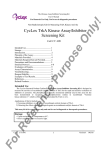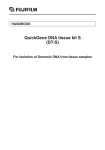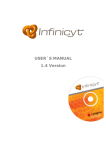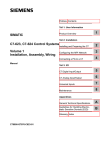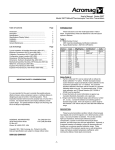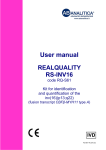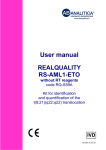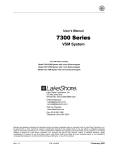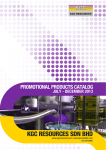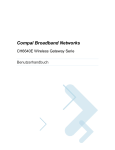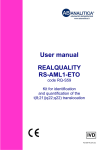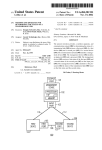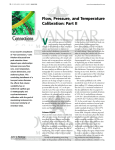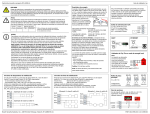Download BCR-ABL
Transcript
USER MANUAL Genequality BCR-ABL cod. 04-55A cod. 04-55R Kit for the detection of the translocation t(9;22) (q34;q11), involving the abl protooncogene on chromosome 9 and the bcr gene on chromosome 22. 04-55A-25(8033622780823)-EN.doc 1 PRODUCT INFORMATION 3 2 KIT CONTENT 4 3 STORAGE AND STABILITY OF THE REAGENTS 6 4 PRECAUTIONS FOR USE 6 5 SAFETY RULES 8 5.1 General safety rules 8 5.2 Safety rules about the kit 8 6 MATERIALS REQUIRED, BUT NOT PROVIDED 10 6.1 Reagents 10 6.2 Instruments 10 6.3 Materials 10 7 PREPARATION OF THE REAGENTS 11 8 INTRODUCTION 12 9 TEST PRINCIPLE 13 10 PRODUCT DESCRIPTION 14 11 COLLECTION, MANIPULATION AND PRE-TREATMENT OF THE SAMPLES 15 12 PROCEDURE 16 12.1 RNA extraction 16 12.2 Retrotranscription (RT) for cDNA synthesis 16 12.3 Direct amplification (first ampification) 17 12.4 Nested Amplification (second amplification) 18 12.5 Visualization of the amplification products 19 12.5.1 Agarose gel electrophporesis 19 12.5.2 Sample loading on the gel 19 13 INTERPRETATION OF THE RESULTS 21 14 TROUBLESHOOTING 23 15 DEVICE LIMITS 25 pag.1 04-55A-25(8033622780823)-EN.doc 16 DEVICE PERFORMANCES 25 16.1 Specificity 25 16.2 Sensitivity 25 17 BIBLIOGRAPHIC REFERENCES 26 17.1 Useful websites Hata! Yer işareti tanımlanmamış. pag.2 04-55A-25(8033622780823)-EN.doc 1 PRODUCT INFORMATION This user manual describes the instructions for use of the following products: BCR-ABL (cod 04-55A) Kit for the detection of the translocation t(9;22) (q34;q11), involving the abl protooncogene on chromosome 9 and the bcr gene on chromosome 22 by DNA amplification (nested RT-PCR) in bcr and abl genes. The kit includes all the reagents for retrotranscription for nested DNA amplification and for agarose gel electrophoresis, the positive and negative controls (cDNA positive and negative for the translocation). Code 04-55A-25 04-55A-50 Product BCR-ABL BCR-ABL Pkg 25 test 50 test BCR-ABL- amplification reagents (cod 04-55R) Kit for the detection of the translocation t(9;22) (q34;q11), involving the abl protooncogene on chromosome 9 and the bcr gene on chromosome 22 by DNA amplification (nested RT-PCR) in bcr and abl genes. The kit includes all the reagents for retrotranscription for nested DNA amplification, the positive and negative controls (cDNA positive and negative for the translocation). Code 04-55R-25 04-55R-50 Product BCR-ABL - amplification reagents BCR- ABL - amplification reagents Pkg 25 test 50 test pag.3 04-55A-25(8033622780823)-EN.doc 2 KIT CONTENT NOTE: In the kits with different codes (A or R) different components are included. (legenda: X = component included in the kit; 0 = component not included in the kit) BOX P cod. 04-55A cod. 04-55R STORE AT – 20°C DESCRIPTION LABEL TUBE (T) OR LID COLOUR 25 test 50 test 8 test green (T) 25 50 8 X X Single-dose RT tubes X X Single-dose premix tubes for BCR-ABL direct amplification red (T) 25 50 8 X X Single-dose premix tubes for BCR-ABL nested amplification yellow (T) 25 50 8 X X Thermostable Taq DNA polymerase AB TAQ 5 U/μL red 1X 30μL 1X 60μL 1X 10μL X X Reverse transcriptase RT enzyme purple 1X 30μL 1X 56μL 1X 10μL X X Reagent mix for retrotranscription RT MIX green 1X 240μL 1X 448μL 1X 80μL SMALL BAG cod. 04-55A cod. 04-55R STORE AT – 20°C DESCRIPTION X X cDNA positive for the BCRABL p210 b3a2 traslocation X X cDNA negative for the BCRABL p210 b3a2 traslocation LABEL TUBE (T) OR LID COLOUR 25 test 50 test 8 test BCR-ABL positive (b3a2) cDNA Blue 1X 6 μL 1X 10 μL 1X 4 μL BCR-ABL negative cDNA Blue 1X 6 μL 1X 10 μL 1X 4 μL pag.4 04-55A-25(8033622780823)-EN.doc BOX F cod. 04-55A cod. 04-55R STORE AT +2°/ +8°C DESCRIPTION 0 Electrophoresis loading buffer (6X solution) X 0 Ethidium Bromide solution (2,5 mg/mL) X 0 DNA Molecular Weight Marker (MW) X LABEL TUBE (T) OR LID COLOUR 25 test 50 test 8 test 6X Blue Blue 1X 100μL 1X 200μL 1X 5 μL Ethidium Bromide Red 1X 100μL 1X 150μL 1X 50μL Yellow 1X 100μL 1X 150μL 1X 50μL TOXIC R 23 68 S 36/37 45 MW Marker BOX A cod. 04-55A cod. 04-55R STORE AT +15°/ +25°C DESCRIPTION LABEL TUBE (T) OR LID COLOUR 25 test 50 test 8 test X 0 Agarose Molecular Biology grade AGAROSE 1X 8 g 1X 14 g 1X 4 g X X Mineral oil Mineral oil 1X 600μL 1X 1,2mL 1X 300μL X 0 Electrophoresis buffer TRIS-Acetate -EDTA pH 8,0 50X TAE 1X 40 mL 1X 60 mL 1X 20 mL pag.5 04-55A-25(8033622780823)-EN.doc 3 STORAGE AND STABILITY OF THE REAGENTS Each component of the kit should be stored according to the directions indicated on the label of the single boxes. In particular: Box P Small bag Box F Box A store at -20°C store at -20°C store at +2/+8°C store at +15/+25°C (room temperature) When stored at the recommended temperature, all test reagents are stable until their expiration date, indicated on the labels. 4 PRECAUTIONS FOR USE • This product is for in vitro use only • The kit should be handled by investigator qualified through education and training in molecular biology techniques applied to diagnostics. • Before starting the kit procedure, read carefully and completely the instruction manual. • Keep the product out of heating sources; • Do not use any part of the kit if over the expiration date; • In case of any doubt about the storage conditions, box integrity or method application, contact AB ANALITICA technical support at: [email protected] before using the kit. In the amplification of nucleic acids, the investigator has to take the following special precautions: • Use filter-tips; pag.6 04-55A-25(8033622780823)-EN.doc • Store the biologic samples, the purified RNAs, the positive controls included in the kit and all the amplification products in different places from where amplification reagents are stored. • Organise the space in different pre- and post-PCR (RT-PCR) units; do not share consumables (pipets, tips, tubes,…) between them. • Change frequently the gloves; • Wash the bench surfaces with 5% sodium hypochloride; • Keep the extracted RNA in an ice-bath during reaction setup. Take care to store RNA samples at -20°C or at -80°C for long term storage. • Thaw the PCR premixes at room temperature before use. Add Taq DNA polymerase and cDNA very quickly at room temperature, better if in an icebath pag.7 04-55A-25(8033622780823)-EN.doc 5 SAFETY RULES 5.1 General safety rules • Wear disposable gloves to handle reagents and clinical samples, wash your hands at the end of work. • Do not pipet with mouth. • Since no known diagnostic method can assure the absence of infective agents, it is a good rule to consider every clinical sample as potentially infectious and handle it as such. • All the devices that get directly in touch with clinical samples should be considered as contaminated and disposed as such. In case of accidental spilling of the samples, clean up with 10% Sodium Hypochloride. The materials used to clean up should be disposed in special containers for contaminated products • Clinical samples, materials and contaminated products should be disposed after decontamination by: immersion in a solution of 5% Sodium Hypochloride (1 volume of Sodium Hypochloride solution every 10 volumes of contaminated fluid) for 30 minutes OR autoclaving at 121°C at least for 2 hours (NOTE: do not autoclave solutions containing Sodium Hypochloride!!) 5.2 Safety rules about the kit The risks for the use of this kit are related to the single components: Dangerous components: ETHIDIUM BROMIDE (included in the kit cod 04-55A only) 3,8-diamino-1-ethyl-6-phenylphenantridiumbromide <2% Description of risk: T (Toxic) pag.8 04-55A-25(8033622780823)-EN.doc RISK SENTENCES AND S SENTENCES R 23 and R 68 S 36/37 45 Toxic for inhalation. Risk of irreversible effects. Wear laboratory coat and disposable gloves. In case of accident or discomfort, seek for medical assistance and show the container or label. R and S sentences refer to the concentrated product, as provided in the kit. In particular for Ethidium Bromide, until the dilution in the agarose gel. In manipulating concentrated Ethidium Bromide, use a chemical dispensing fume cabinet. Always wear disposable gloves and laboratory coat in manipulating the diluted Ethidium solution as well. The product can not be disposed with the common waste. It must not reach the drainer system. For the disposal, follow the local law. In case of accidental spilling of Ethidium Bromide, clean with Sodium hypochloride and water. Safety data sheet (MSDS) of the product is available upon request. pag.9 04-55A-25(8033622780823)-EN.doc 6 MATERIALS REQUIRED, BUT NOT PROVIDED 6.1 Reagents • • • • Reagents for RNA extraction; Sterile DNase and RNase free water; Distilled water; Reagents for agarose gel electrophoresis (necessary for cod. 04-55R) 6.2 Instruments • Laminar flow cabinet (use is recommended while adding TAQ polymerase to the amplification premix to avoid contamination; it would be recommended to use another laminar flow cabinet to add the extracted RNA to the RT tubes and to add cDNA or the product of the first amplification to the premix tubes. • Micropipettes (range: 0,2-2 µL; 0,5-10 µL; 2-20 µL); • Thermal cycler; • Thermoblock or thermal bath • Microcentrifuge (max 12-14.000 rpm); • Balance; • Magnetic heating stirrer or microwave. • Chemical cabinet (its use is recommended in handling Ethidium Bromide); • Horizontal electrophoresis chamber for agarose minigel; • Power supply (50-150 V); • UV Transilluminator; • Photo camera or image analyzer. 6.3 Materials • • • • • Disposable gloves; Disposable sterile filter-tips (range: 0,2-2 µL; 0,5-10 µL; 2-20 µL) Graduate cylinders (1 L) for of buffer dilution; Pyrex bottle or Becker for agarose gel preparation; Parafilm. pag.10 04-55A-25(8033622780823)-EN.doc 7 PREPARATION OF THE REAGENTS Preparation of 1 L of 1X TAE buffer: Mix 20 mL of 50X TAE (included in the kit cod 04-55A only) with 980 mL of distilled water. pag.11 04-55A-25(8033622780823)-EN.doc 8 INTRODUCTION The study of leukemias and lymphomas allowed the understanding of the cellular and molecular mechanisms at the base of many neoplastic pathologies. The molecular rearrangement known as Philadelphia (Ph) chromosome was the first clonal marker identified in a neoplastic pathology (Nowell and Hunderford, 1960). The molecular events at the base of the translocation of the Philadelphia chromosome are one of the first found of a translocated oncogene in an human cancer (Groffen et al., 1984). Ph derives from the translocation t(9;22)(q34;q11) and it is a marker in more than 95% of the cases of Chronic Mieloid Leukemias and it is found also in more than 10-25% of patients affected by Acute Limphoblastic Leukemia, where it is a negative prognostic factor, both in adult and children. At the genetic level, the translocation opposes the c-abl proto-oncogene, usually located in chromosome 9, to the bcr gene specific region encompassing the exons 12, 13, 14, 15 and called major breakpoint cluster region (M-BCR) on chromosome 22. The bcr-abl fusion gene is transcripted in a hybrid mRNA and translated into a fusion protein (p210BCR-ABL) of 210 kDa that acquires transforming activity that stimulates uncontrolled cellular proliferation (Melo, 1996; Verfaillie, 1998). The translocation can be detected at the molecular level by mean of the RTPCR technique, that consists in total RNA extraction from the sample, retrotranscription in cDNA and subsequent amplification of the regions of interest. This determination provide useful information for diagnosis and prognosis of this type of Leukemias but, moreover, allows the monitoring of the minimal residual disease (MRD) with repercussions on the therapy. For Minimal Residual Disease (MRD) is intended the amount of neoplastic cells present in an individual during the different phases of chemiotherapy, that are below the detectable level with normal cytomorphologic techniques. Even if an aggressive chemiotherapy contributed to the progresses obtained in the treatment of Leukemias, a significant percentage of cases show recidives at variable time from the beginning of the treatment. The recidive is the expression of the persistence of a percentage of cells resistant to the therapy, whose characteristics were unknown for long, due to the limited sensitivity of the analytical techniques available. pag.12 04-55A-25(8033622780823)-EN.doc The PCR technique opened new perspectives for more efficient and extended applications for the minimal residual disease (MRD) monitoring (van Dongen et al., 1998; Hochhaus et al., 2000). 9 TEST PRINCIPLE PCR method (Polymerase Chain Reaction) has been the first method of DNA amplification described in literature. (Saiki RK et al., 1985). It can be defined as an in vitro amplification reaction of a specific part of DNA (target sequence) by a thermo-stable DNA polymerase. Three nucleic acid segments are involved in the reaction: double stranded DNA template to be amplified (target DNA) and two single-stranded oligonucleotides “primers” that are designed in order to anneal specifically to the template DNA. The DNA polymerase begins the synthesis process at the region marked by the primers and synthesizes new double stranded DNA molecules, identical to the original double stranded target DNA region, by facilitating the binding and joining of the complementary nucleotides that are free in solution (dNTPs). After several cycles, one can get millions of DNA molecules which correspond to the target sequence. The sensitivity of this test makes it particularly suitable for the application in laboratory diagnostics. Moreover, the amplification reaction can be executed from a wide range of biological samples and since it allows to amplify very small DNA fragments, the starting DNA can be also partially degraded. By the association between the retrotranscription technique with PCR, it is possible to study expressed sequences. pag.13 04-55A-25(8033622780823)-EN.doc 10 PRODUCT DESCRIPTION The molecular approach of this method for the study of the translocation of the bcr and abl genes, coding for the p210 BCR-ABL protein, consists in a first step of retrotranscription of a previously extracted RNA, followed by nested amplification of the regions of interest. The nested PCR technique guarantees the necessary sensitivity for its application in the minimal residual disease (MRD) monitoring. With this method the translocations b3a2, b2a2, b2a3 e b3a3 can be detected, that all give origin to the p210 BCR-ABL protein. The co-amplification of a genetic region coding for the ß2-microglobulin ubiquitously expressed, constitutes a control of the starting sample integrity and of a successful retrotranscription reaction. The primers for ß2-microglobulin amplification are specific for cDNA: in absence of the cDNA target they do not give any amplification product. A negative result in the amplification of the ß2-microglobulin gene indicates that there are very few intact RNA molecules in the sample, not sufficient for the detection of BCR-ABL translocation or that something in the retrotranscription didn’t work. This valuable tool helps the operator to assess false negative results and doesn’t require extra-time because the amplification of the ß2-microglobulin gene is in multiplex with BCR-ABL amplification. The kit includes as amplification controls a cDNA positive (b3a2) and a cDNA negative for the BCR-ABL translocation. The amplification of the reference cDNA guarantees the correct course of the reaction (DNA band of 353 bp for DNA positive for the translocation p210 b3a2 and a DNA band of 535 bp for DNA negative for the translocation p210) . The kit is in premix format: all the reagents for the amplification are pre-mixed and aliquoted in monodose test tubes to which Taq polymerase and the cDNA will be added. This premix format allows the reduction of the manipulation steps in preamplification, with a considerable time saving for the operator, the repeated freezing/thawing of reagents (that could alter the product performances) is avoided and, above all, this form reduces at minimum the risk of contamination, so the risk to get false positive results Nevertheless, it is always recommended to use all the proper amplification controls. pag.14 04-55A-25(8033622780823)-EN.doc 11 COLLECTION, MANIPULATION AND PRETREATMENT OF THE SAMPLES The starting sample for the detection of BCR-ABL translocation is peripheral whole blood or medullar blood. Collect the whole blood following the routine procedures and all the usual sterility precautions. Blood should be treated with EDTA. Other coagulating agents, as heparin, are strong inhibitors of TAQ polymerase and so they could alter the efficiency of the RT-PCR reaction. Fresh blood can be stored at +2 / +8°C for a maximum of 4 hours from collection, after that time it is necessary to proceed with RNA extraction or lymphocyte isolation. The lymphocyte pellet must be stored dry at -80°C until RNA extraction. pag.15 04-55A-25(8033622780823)-EN.doc 12 PROCEDURE 12.1 RNA extraction Any RNA extraction method can be used, provided that it allows to obtain a sufficiently pure and not fragmented RNA. Please follow the instructions below for the amount of RNA to use in the retrotranscription (1-5 µg). For any problem in method application you can contact AB ANALITICA technical support at: [email protected] . 12.2 Retrotranscription (RT) for cDNA synthesis To each RT tube add: extracted RNA mineral oil 9 μL* 20 μL *NOTE: 9 μL is the volume available for the reaction. Remember that the ideal amount of RNA to be transcripted is about 1-5 μg. Do not use less than 250 ng. If RNA volume is less than 9 μL, adjust the volume with sterile DEPCwater. Put the microtubes into the thermalcycler programmed as below: 1 cycle 70°C 10 min 4°C 1 min 25°C 10 min Centrifuge briefly, then add 8 μL of RT-mix and mix, centrifuge for few seconds and incubate in the thermalcycler at: 1 cycle 42°C pag.16 04-55A-25(8033622780823)-EN.doc 2 min Add 1 μL of RT Enzyme, mix and centrifuge briefly, incubate in the thermalcycler: 1 cycle 42°C 50 min 70°C 15 min 4°C 1 min At the end of the cycle the retrotranscripted samples can be stored in the fridge (+4°C) until the subsequent amplification. 12.3 Direct amplification (first ampification) For each sample add to a red tube: AB Taq cDNA 0,25 µL 2 µL It is important to include in each experiment a negative control to monitor the contamination (add to the mix distilled water instead of cDNA) and 2 μL of the positive control and of the negative control for the translocation included in the kit Centrifuge shortly, then incubate the tubes in a thermalcycler programmed as follow: 1 cycle 42 cycles 1 cycle 95°C 1 min 94°C 30 sec 55°C 60 sec 72°C 60 sec 72°C 7 min Proceed directly with the second amplification. pag.17 04-55A-25(8033622780823)-EN.doc 12.4 Nested Amplification (second amplification) For each sample add to a yellow tube: AB Taq 1st amplification product 0,25 µL 1 µL Amplify again the negative control and the reference controls used in the direct PCR. If considered necessary, it is possible to prepare also a negative control of the nested amplification, by adding to the nested mix 1 μL of sterile water instead of the direct amplification product. Centrifuge shortly, then incubate the tubes in a thermalcycler programmed as follow: 1 cycle 95°C 1 min 94°C 30 sec 60°C 60 sec 72°C 60 sec 94°C 30 sec 26 cycles 55°C 60 sec 72°C 60 sec 72°C 7 min 5 cycles 1 cycle Amplification products length: translocated BCR-ABL: 353 bp (b3a2) 278 bp (b2a2) 179 bp (b2a3) 104 bp (b3a3) β2 microglobulin: 535 bp pag.18 04-55A-25(8033622780823)-EN.doc 12.5 Visualization of the amplification products 12.5.1 Agarose gel electrophoresis Prepare a 3% agarose gel: weight 1,5 g of Agarose and pour it into 50 mL of 1X TAE. Leave the solution on a magnetic stirring heater or in a microwave until the solution becomes clear. Allow the gel to cool to “hand warm” (3-5 min), then add 10 µL of Ethidium Bromide solution (2.5 mg/mL) NOTICE: Ethidium Bromide is a strong mutagenic agent: Always wear gloves and preferably work under a chemical safety cabinet during the handling of this reagent or gels containing it. Place the gel into the appropriate gel casting tray, with the comb placed in and allow the gel to cool at room temperature or in a fridge until the gel becomes solid. When the gel is solidified, remove carefully the comb (pay attention to not damage the gel wells) transfer the tray into an electrophoresis chamber and pour the appropriate amount of TAE 1X buffer so that it covers completely the gel (about 1-2 mm over the gel surface). 12.5.2 Sample loading on the gel For the visualization of the amplification products, mix into a tube or directly on a parafilm layer: 2 µL 10 µL 6X Blue* amplification product 2 µL 10 µL 6X Blue* DNA Molecular Weight Marker* and * NOTE: 6X Blue and DNA Molecular Weight Marker are included in cod. 04-55A only; if other loading buffers or DNA molecular weight markers are used, refer to the manufacturer’s instructions. pag.19 04-55A-25(8033622780823)-EN.doc Load the mixture in the gel wells; switch on the power supply and set the voltage between 80-100 V. Run the gel for about 40 min, then place the gel on an UV transilluminator and analyze the results by comparing the size of the amplification products with the reference Molecular Weight Marker. * DNA Molecular Weight Marker (Marker MW): DNA fragments: 501-489, 404, 353, 242, 190, 147, 110, 89, 67, 34, 26 bp. (NOTE: In a 3% agarose gel the 501-489 bp bands usually are not clearly resolved and appear as an unique band; the 26 and 34 bp bands are sometimes too small to be visible in a 3% agarose gel (because of their low molecular weight). NOTICE: UV rays are dangerous for skin and, above all, eyes: always wear gloves and safety glass or make use of the protection screen of the UV transilluminator. pag.20 04-55A-25(8033622780823)-EN.doc 13 INTERPRETATION OF THE RESULTS The included controls should show the following results: CONTROL cDNA positive for ABL (b3a2) translocation cDNA negative for BCR-ABL p210 Traslocation Negative Control RESULT INTERPRETATION BCR- 353 bp band The amplification reaction for the identification of BCR-ABL translocation works correctly. The amplification of the ß2-microglobulin gene works correctly. 535 bp band Absence of bands Nested amplification Absence of negative control bands No contaminations in the first amplification. No contaminations in the second amplification. Then the interpretation of the bands on agarose gel follows the table below: DNA BAND RESULT INTERPRETATION ß2-microglobulin band Absent degraded RNA; errors in the retrotranscription. (repeat the RT-PCR: if bands are not visible again, repeat the RNA extraction). Suitable sample and negative for BCR-ABL traslocation. BCR-ABL traslocation (b3a2, b2a2, b2a3, b3a3) ß2-microglobulin band. band Absent Present traslocation BCR-ABL (b3a2, b2a2, b2a3, b3a3) ß2-microglobulin band. band Absent traslocation BCR-ABL (b3a2, b2a2, b2a3, b3a3). band Present Present or absent* Suitable sample and positive for BCR-ABL traslocation. *In all the samples that are negative for the BCR-ABL traslocation, the ß2microglobulin band at 535 bp must be always present. In translocated samples the signal can be very low or not visible, due to the fact that this is a multiplex amplification, studied for enhancing the identification of the translocation even if present in a low percentage of cells only. pag.21 04-55A-25(8033622780823)-EN.doc 1 2 3 4 5 535 bp (ß2-microglobulin) 353 bp (b3a2) Fig 1. 3% agarose gel electrophoresis of nested PCR products. 1. 2. 3. 4. 5. DNA Molecular Weight Marker Negative sample for BCR/ABL translocation Negative sample for BCR/ABL translocation Positive sample for BCR/ABL translocation (b3a2) Negative control. pag.22 04-55A-25(8033622780823)-EN.doc 14 TROUBLESHOOTING 1. After the nested PCR reaction neither sample bands, nor control bands. TAQ polymerase was not correctly added to the premix - Use pipets and tips of suitable volumes (pipet range 0,2 - 2 μL) Check visually that TAQ polymerase diffuses in the premix: this is easy because the enzyme is dissolved in glycerol that has higher density. Alternatively, put the TAQ polymerase on the tube wall, then centrifuge briefly. The thermalcycler was not correctly programmed. – Check the conformity of the thermalcycler program and the temperature profile in the instruction manual. The kit doesn’t work properly – Store the premixes, the TAQ polymerase and reference DNA at -20°C; – Avoid repeated freezing/thawing of the reagents. 2. Neither amplification bands for ß2-microglobulin nor for the tested sample, but good signals for the controls. Problems may be occurred during the extraction step, verify the following: – be sure that the extraction method is adequate and that you followed all the instructions correctly; – consult the troubleshooting section of the extraction kit’s user manual; – repeat the RNA extraction starting from a new sample. Problems may be occurred during the retrotranscription step, verify the following: – The thermalcycler was not programmed correctly: check the conformity between the thermalcycler program and the temperature profile in the instruction manual, then repeat the reaction with the correct program; – The Reverse Transcriptase was not added correctly: use pipets and tips of suitable volumes (pipet range 0,2 - 2 μL with proper tips); pag.23 04-55A-25(8033622780823)-EN.doc – Check visually that Reverse Transcriptase diffuses in the premix: this is easy because the enzyme is dissolved in glycerol that has a higher density. Alternatively, put the drop of Reverse Transcriptase on the tube wall, then centrifuge briefly. 3. Presence of aspecific products or extra-bands after agarose gel electrophoresis. The thermalcycler do temperature changes itoo slowly. – Program a thermalcycler revision. The setup of the amplification reaction at room temperature took too long. – Speed up the work time at room temperature – Put the reagents in an ice-bath during reaction setup. The starting sample contained partially degraded RNA. – Repeat the extraction using another clinical sample. For any further problem you can contact AB ANALITICA technical support: e-mail: [email protected] pag.24 04-55A-25(8033622780823)-EN.doc 15 DEVICE LIMITS The kit can have reduced performances if: • • The clinical sample is not suitable for the analysis (blood sample not properly stored or treated with heparin as anti-coagulant) The kit was not stored in the proper conditions, as indicated on the kit’s labels. 16 DEVICE PERFORMANCES 16.1 Specificity Primer sequence alignment in the most important databanks shows the absence of unspecific alignment. Cross-reaction with genomic DNA was not detected. 16.2 Sensitivity Several bibliographic evidences indicate that the nested RT-PCR for the identification of the translocated BCR-ABL mRNA is the most sensitive method for the analysis of the minimal residual disease (MRD), allowing the detection of one translocated cell in 106 healthy cells (Hochhaus et al., 2000; van Dongen et al., 1999). Laboratory tests gave almost the same results (one translocated cell in 3-5 x 106 healthy cells): the reported values depend on the number of mRNA molecules present in a neoplastic cell, that can be variable for many reasons. pag.25 04-55A-25(8033622780823)-EN.doc 17 BIBLIOGRAPHIC REFERENCES Nowell PC, Hunderford DA. Science 132, 1497, 1960. Groffen J, Stevenson JR, Heisterkamp N et al. Cell 36, 93-99, 1984. Saiki RK, S Scharf, F Faloona, KB Mullis, GT Horn, HA Erlich and N Arnheim, Science 230, 1350-1354, 1985. Melo JV. Leukemia 10, 751-756, 1996. Verfaillie CM. Biology and therapy of chronic myelogenous leukaemia vol 12, num 1, 1998. van Dongen JJ et al. Lancet 352, 1731-1738, 1998. Hochhaus A, Weisser A, La Rosèe P et al. Leukemia 14, 998-1005, 2000. Van Dongen JJ, Maclntyre EA, Gabert JA et al. Leukemia12, 1901-1928, 1999. 17.1 Useful websites www.hematology.org www.bloodjournal.org www.bloodline.net www.haematologica.it www.il-st-acad-sci.org/data6.html http://medocs.ucdavis.edu/IMD/420A/dib/index.htm http://web.tiscali.it/ematologia www.ematologia-italia.net/frame_b.htm www.simti.it http://stemcells.alphamedpress.org www.blacksci.co.uk/uk/society/bsh pag.26 04-55A-25(8033622780823)-EN.doc pag.27 04-55A-25(8033622780823)-EN.doc pag.28 04-55A-25(8033622780823)-EN.doc t AB ANALITICA srl Via Svizzera 16 - 35127 PADOVA, (ITALY) Tel +39 049 761698 - Fax +39 049 8709510 e-mail: [email protected]
































